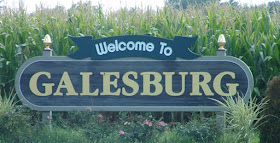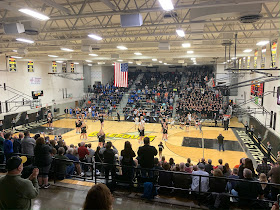I started teaching and coaching at Galesburg High School in the Fall of 1974. I can still vividly remember our first pep rally in the old auditorium, which held over 2000 people. For the pep rally, it was filled- main floor had no empty seats and balcony looked full as well. When Sally Rynott cranked up the band to play Hi Yo Silver, the entire student body got to their feet and began clapping in rhythm. It was unbelievable, it gave me chills.
Game night for boys basketball, students filled the entire main floor on the north side of the gym. They were active and they were involved. I share these stories to try to draw a picture of the “good old days” at Galesburg High School. GHS definitely was a big school with highly involved students.
Galesburg and Galesburg High School have changed in the last 50 years. The population of Galeburg has steadily decreased:
1964- 38,300
2000- 33,706
2022- 29,800
While GHS is still a large school, its enrollment peaked in the 1970's and since that time has declined. Here are the enrollments listed in the IHSA program when Galesburg made State Tourney appearances:
1976- 2521 students (Counting 9th-12th grades)
1998- 1598 students (Counting 9th-12th grades)
2024- 1232 students (Counting 9th-12th grades)
The decline in the population of Galesburg, and the enrollment at GHS has impacted a variety of thing in our community. It has had an impact on the GHS athletic programs. As Galesburg's enrollment has decreased, many of their athletic rivals have either increased enrollments or at least remained.
In the Western Big Six, Moline, Quincy, Rock Island, and UTHS all had enrollments similar to Galesburg in the 1970's when the Conference was formed, today has 500 to 800 less students than these schools.
Traditionally the Peoria public schools and the schools surrounding Peoria were all smaller than Galesburg in the 1970's. Some schools like Dunlap were only 1/3 the size of Galesburg. Washington, Dunlap, Morton, and Metamora are all schools who have grown tremendously, and are continuing to grow. Today Pekin, Washington, Richwoods, Dunlap, and Peoria are all bigger than Galesburg HS. All signs are that all of these schools will continue to get bigger.
Athletically, it is not just enrollment which impacts competition. The mobility of the population also effects competitive balance. When athletes transfer from one school to another, it changes the balance of competition. Galesburg boys basketball benefitted tremendously by the transfer of Rod Thompson in 1998, but transfer to GHS have been view and far between the last fifty years.
In the meantime, in the larger cities like Peoria and the Quad Cities, transfers have become more and more common place. The running joke at a school in the metro St.Louis area was that several girls basketball players could not get permits for driver's ed because their residence was in Missouri. In Chicago, there are stories of brothers in the same house going to different schools.
In the QC's and Peoria when you study the rosters, some schools have players who did not attend their school district's junior high schools, but arrive for high school. Transferring from one school to another in a larger city is easier. It takes little imagination how much better any sport at GHS would be if you added one all-conference type player to a roster.
Some movement is simple economics, where parents move with a business or for a better job. In these larger cities, there are more job opportunities that entice people to move to their communities.
And movement in urban areas is much more convenient. With so many schools within miles of each other, a parent can move residence from one school district to another school district without switching jobs. Galesburg is not a destination for transfers.
In athletics, numbers do matter. The school that has won more State Championships than any other school in Illinois is New Trier with 3908 students. The WB6 Conference has an All-Sports Sweepstake. It is an award given at the end of the year to the school who scores the highest with their places in all the sports. Any guess who has won that award more than anyone else? Moline with an enrollment of 2093 has won the All-Sports Sweepstakes by far the most of any school.
Initially going to two-classes hurt GHS sports. Whether in track or basketball, the Streaks at the first level were not competing against smaller schools. In the early 2000's when the IHSA went to 3-class and 4-class in some sports, it didn't benefit all sports but it benefited many sports.
In the 1960's and 1970's, GHS had great athletic success. The enrollment was similar to the Quad City schools, and bigger than most of the Peoria schools. In basketball, baseball, football, and golf, GHS was able to compete on a State level with anyone in Illinois. In the State series in those sports, it didn't matter the size of schools or the location of schools, Galesburg was consistently one of the best athletic programs in the State. With no girls sports, GHS won 27 Regional Championships and 5 State top four finishes. Both are the best of any decade.
While Galesburg High School had 1232 students enrolled, only 348 students participated in sports last year. If it was an even split, it would mean there were only 174 males and 174 females playing sports at GHS. Only 28% of GHS students participate in athletics. Galesburg does not have the same percentage of students involved in activities as they did in the 1960's and 1970's. As Galesburg HS enrollment has gone down, it appears the student involvement is also shrinking.
Compare that to Farmington with an enrollment of 354 and over 100 males out for football. On the boy's side of sports, Farmington has over 60% of students involved in sports. So you might say GHS's enrollment has gone down, and the GHS athletic numbers have diminished even more.
In athletics, numbers do matter. The school that has won more State Championships than any other school in Illinois is New Trier with 3908 students. The WB6 Conference has an All-Sports Sweepstake. It is an award given at the end of the year to the school who scores the highest with their places in all the sports. Any guess who has won that award more than anyone else? Moline with an enrollment of 2093 has won the All-Sports Sweepstakes by far the most of any school.
Other small schools have shown that you can compete successfully against bigger schools. Sterling consistently out-performs their enrollment- in recent years they have been a state power in both football and volleyball. Geneseo and Alleman over most of the last 50 years consistently beat larger schools in football. Tiny Camp Point Central has found a way to be a State power in multiple sports and win State Championships, while also beating larger schools.
The template for smaller schools to be successful competing vs larger schools seems to be clear. Most of the school who have had success get their athletes to do four things:
1- Commit to the weight room.
2- Become multi-sport athletes.
3- Work to improve in the off-season.
4- Be willing to be coached.
Initially going to two-classes hurt GHS sports. Whether in track or basketball, the Streaks at the first level were not competing against smaller schools. In the early 2000's when the IHSA went to 3-class and 4-class in some sports, it didn't benefit all sports but it benefited many sports.
Going forward in basketball, the present dividing line between 4A and 3A is at 1519, which puts Galesburg in 3A. As far as the rest of the WB6:
4A- Moline, Rock Island, Quincy, UT
3A- Galesburg, Sterling, Geneseo
2A- Alleman
2A- Alleman
It would certainly appear over the next ten years, Galesburg will continue to be 3A, and some of their opponents are likely to slide up to 4A. Washington and Dunlap are still 3A but would appear several years away from 4A.
In the 1960's and 1970's, GHS had great athletic success. The enrollment was similar to the Quad City schools, and bigger than most of the Peoria schools. In basketball, baseball, football, and golf, GHS was able to compete on a State level with anyone in Illinois. In the State series in those sports, it didn't matter the size of schools or the location of schools, Galesburg was consistently one of the best athletic programs in the State. With no girls sports, GHS won 27 Regional Championships and 5 State top four finishes. Both are the best of any decade.
While the combination of enrollment and lack of mobility make competing in sports harder for GHS teams, it is still possible for athletes to be successful. From 2000-2009 GHS teams won 15 IHSA Sectional Championships, that is the second most in any decade in GHS history. From 2011-2020, GHS teams won 26 Regional Championship, that is within two of the most in any decade in GHS history.
Can Galesburg Still Compete? While numbers create a definite disadvantage in competition, the lack of numbers can be overcome. Galesburg athletes are successful today if they are willing to do the same things that made the great athletes in the 1960's successful- work to get better in the off-season, accept coaching, commit to their teams, and have pride in being a Silver Streak.
So yes, Galesburg definitely still can compete successfully, and they are doing that right now.









No comments:
Post a Comment